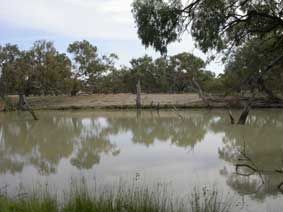Major Group: Acarina
Minor Group: Trombidioidea |
Descriptive Features: body soft, not heavily sclerotized
idiosome, (body) legs and pedipalps covered in short thick setae
Size: |
|
|
|
Distribution: SNSW +
Sensitivity Rating: none
Functional Feeding Group: predators
|

|
Billabong Creek, Conargo NSW |
|
|
Ecology: Instream habitat: Trombidodea species occur in vegetated margins of slow flowing streams.
Feeding ecology: Larvae are parasitic on insects and other invertebrates. Free-living post-larval stages are predators of small arthropods.
Habit: Larval trombid mites disperse via their hosts. Water mites can detect prey and sexual partners using chemical cues.
Life history: In Europe, the life cycle of aquatic Trombidodea species is usually univoltine. However nymphs that appear late in summer or autumn may fail to mature in the same year and will complete their life cycle in 2nd or 3rd year. Developments and survival of each life cycle stage is affected by the temperature, relative humidity and food availability/quality. Development from egg to adult takes approximately 10 months. |
| |
Information Sources: Krantz & Walter 2009, Harvey & Growns 1998, Halliday 2000, Zhang 1998 |
|
|
|